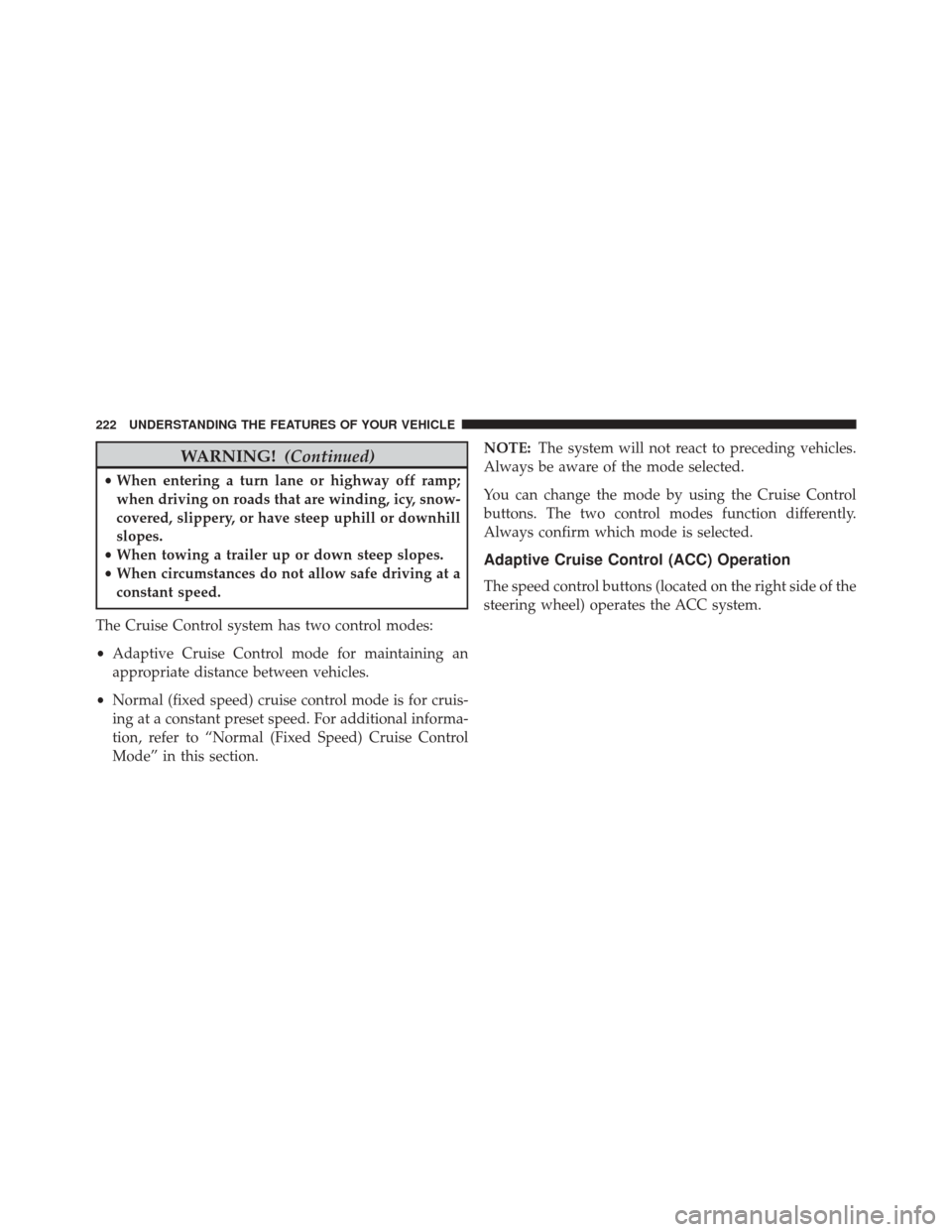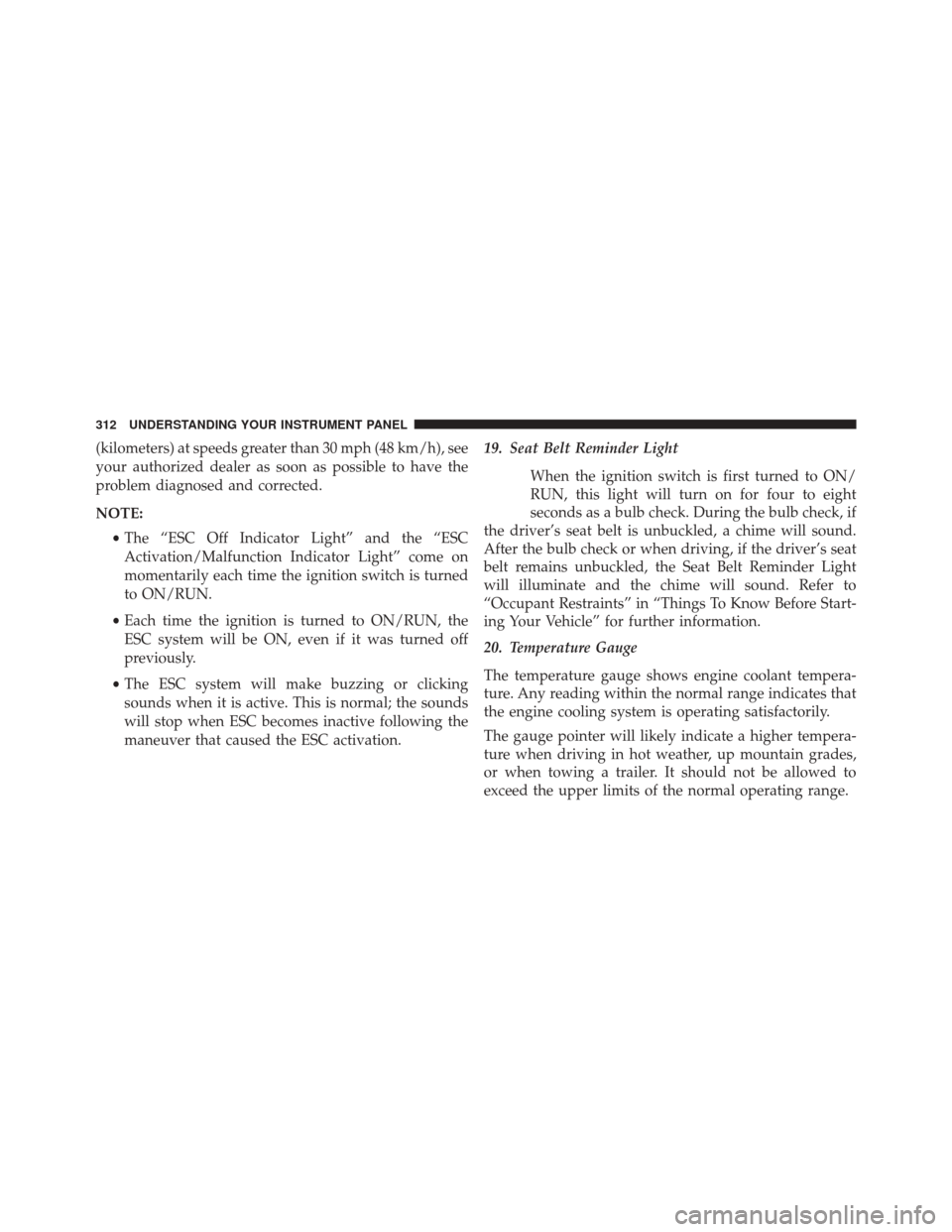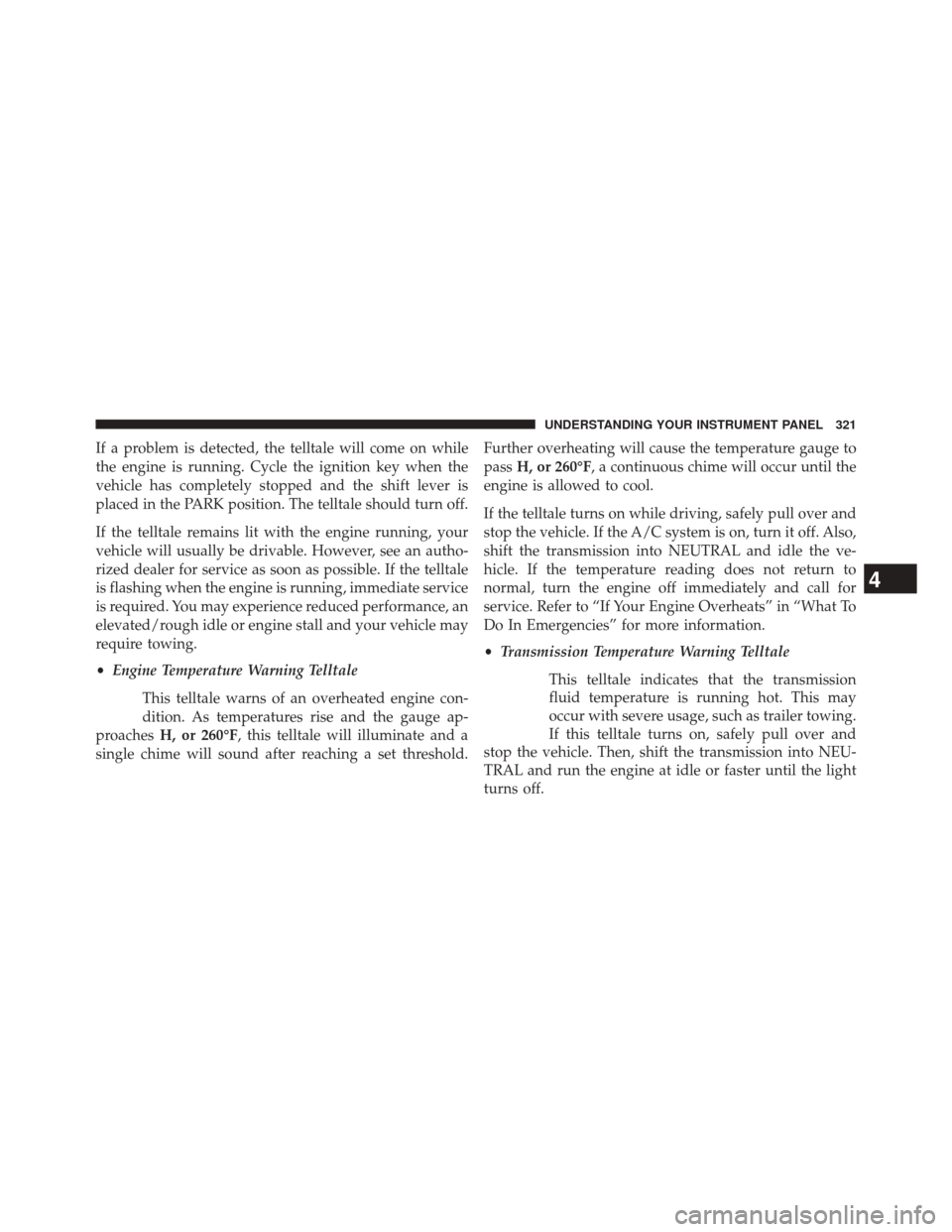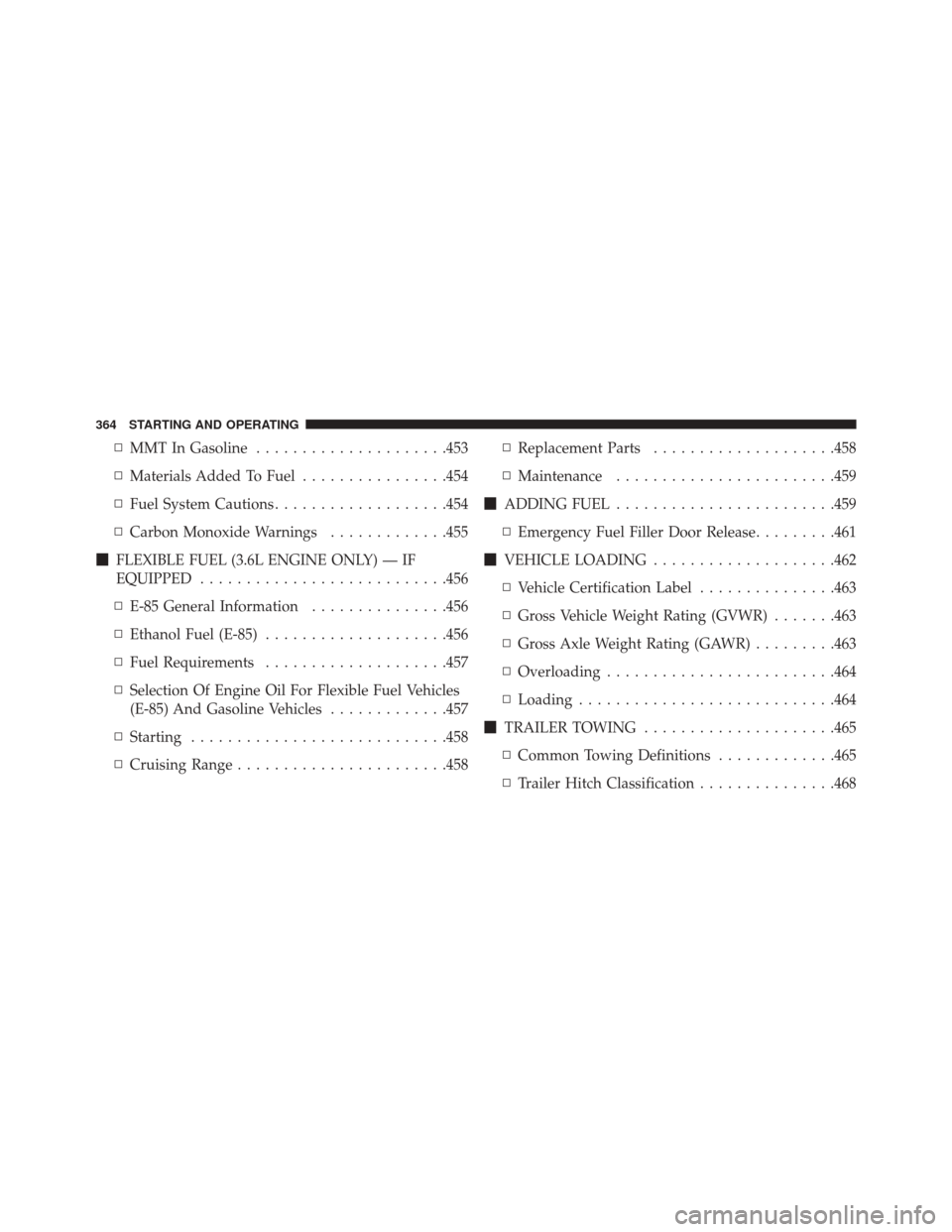Page 121 of 615

The BSM detection zone covers approximately one lane,
12 ft (3.8 m) on both sides of the vehicle. The zone starts
at the outside rear view mirror and extends approxi-
mately 23 ft (7 m) to the rear of the vehicle. The BSM
system monitors the detection zones on both sides of thevehicle when the vehicle speed reaches approximately
6 m.p.h. (10 km/h) or higher and will alert the driver of
vehicles in these areas.
NOTE:
•
The BSM system does NOT alert the driver about
rapidly approaching vehicles that are outside the de-
tection zones.
• The BSM system detection zone DOES NOT change if
your vehicle is towing a trailer. Therefore, visually
verify the adjacent lane is clear for both your vehicle
and trailer before making a lane change. If the trailer or
other object (i.e., bicycle, sports equipment) extends
beyond the side of your vehicle, this may result in the
BSM warning light remaining illuminated the entire
time the vehicle is in a forward gear.
The area on the rear fascia where the radar sensors are
located must remain free of snow, ice, and dirt/road
BSM Warning Light
3
UNDERSTANDING THE FEATURES OF YOUR VEHICLE 119
Page 224 of 615

WARNING!(Continued)
•When entering a turn lane or highway off ramp;
when driving on roads that are winding, icy, snow-
covered, slippery, or have steep uphill or downhill
slopes.
• When towing a trailer up or down steep slopes.
• When circumstances do not allow safe driving at a
constant speed.
The Cruise Control system has two control modes:
• Adaptive Cruise Control mode for maintaining an
appropriate distance between vehicles.
• Normal (fixed speed) cruise control mode is for cruis-
ing at a constant preset speed. For additional informa-
tion, refer to “Normal (Fixed Speed) Cruise Control
Mode” in this section. NOTE:
The system will not react to preceding vehicles.
Always be aware of the mode selected.
You can change the mode by using the Cruise Control
buttons. The two control modes function differently.
Always confirm which mode is selected.
Adaptive Cruise Control (ACC) Operation
The speed control buttons (located on the right side of the
steering wheel) operates the ACC system.
222 UNDERSTANDING THE FEATURES OF YOUR VEHICLE
Page 240 of 615
Precautions While Driving With ACC
In certain driving situations, ACC may have detection
issues. In these cases, ACC may brake late or unexpectedly.
The driver needs to stay alert and may need to intervene.
Adding A Trailer Hitch
The weight of a trailer/hitch may affect the performance
of ACC. If there is a noticeable change in performance
following the installation of a trailer/hitch, or if the ACC
performance does not return to normal after removing
the trailer/hitch see your authorized dealer.
Offset Driving
ACC may not detect a vehicle in the same lane that is
offset from your direct line of travel, or a vehicle merging
in from a side lane. There may not be sufficient distance
to the vehicle ahead. The offset vehicle may move in and
out of the line of travel, which can cause your vehicle to
brake or accelerate unexpectedly.
Adaptive Cruise Control (ACC) Unavailable Warning
238 UNDERSTANDING THE FEATURES OF YOUR VEHICLE
Page 258 of 615

•ParkSense®, when on, will MUTE the radio when it is
sounding a tone.
• Clean the ParkSense® sensors regularly, taking care
not to scratch or damage them. The sensors must not
be covered with ice, snow, slush, mud, dirt or debris.
Failure to do so can result in the system not working
properly. The ParkSense® system might not detect an
obstacle behind or in front of the fascia/bumper, or it
could provide a false indication that an obstacle is
behind or in front of the fascia/bumper.
• Ensure the ParkSense® system is OFF if objects such as
bicycle carriers, trailer hitches, etc. are placed within
30 cm from the rear fascia/ bumper. Failure to do so
can result in the system misinterpreting a close object
as a sensor problem, causing the “SERVICE PARK
ASSIST SYSTEM” message to be displayed in the
EVIC.CAUTION!
• ParkSense® is only a parking aid and it is unable to
recognize every obstacle, including small obstacles.
Parking curbs might be temporarily detected or not
detected at all. Obstacles located above or below
the sensors will not be detected when they are in
close proximity.
• The vehicle must be driven slowly when using
ParkSense® in order to be able to stop in time
when an obstacle is detected. When backing up, it
is recommended that the driver looks over his/her
shoulder when using ParkSense®.
256 UNDERSTANDING THE FEATURES OF YOUR VEHICLE
Page 314 of 615

(kilometers) at speeds greater than 30 mph (48 km/h), see
your authorized dealer as soon as possible to have the
problem diagnosed and corrected.
NOTE:•The “ESC Off Indicator Light” and the “ESC
Activation/Malfunction Indicator Light” come on
momentarily each time the ignition switch is turned
to ON/RUN.
• Each time the ignition is turned to ON/RUN, the
ESC system will be ON, even if it was turned off
previously.
• The ESC system will make buzzing or clicking
sounds when it is active. This is normal; the sounds
will stop when ESC becomes inactive following the
maneuver that caused the ESC activation. 19. Seat Belt Reminder Light
When the ignition switch is first turned to ON/
RUN, this light will turn on for four to eight
seconds as a bulb check. During the bulb check, if
the driver’s seat belt is unbuckled, a chime will sound.
After the bulb check or when driving, if the driver’s seat
belt remains unbuckled, the Seat Belt Reminder Light
will illuminate and the chime will sound. Refer to
“Occupant Restraints” in “Things To Know Before Start-
ing Your Vehicle” for further information.
20. Temperature Gauge
The temperature gauge shows engine coolant tempera-
ture. Any reading within the normal range indicates that
the engine cooling system is operating satisfactorily.
The gauge pointer will likely indicate a higher tempera-
ture when driving in hot weather, up mountain grades,
or when towing a trailer. It should not be allowed to
exceed the upper limits of the normal operating range.
312 UNDERSTANDING YOUR INSTRUMENT PANEL
Page 323 of 615

If a problem is detected, the telltale will come on while
the engine is running. Cycle the ignition key when the
vehicle has completely stopped and the shift lever is
placed in the PARK position. The telltale should turn off.
If the telltale remains lit with the engine running, your
vehicle will usually be drivable. However, see an autho-
rized dealer for service as soon as possible. If the telltale
is flashing when the engine is running, immediate service
is required. You may experience reduced performance, an
elevated/rough idle or engine stall and your vehicle may
require towing.
•Engine Temperature Warning Telltale
This telltale warns of an overheated engine con-
dition. As temperatures rise and the gauge ap-
proaches H, or 260°F, this telltale will illuminate and a
single chime will sound after reaching a set threshold. Further overheating will cause the temperature gauge to
pass
H, or 260°F, a continuous chime will occur until the
engine is allowed to cool.
If the telltale turns on while driving, safely pull over and
stop the vehicle. If the A/C system is on, turn it off. Also,
shift the transmission into NEUTRAL and idle the ve-
hicle. If the temperature reading does not return to
normal, turn the engine off immediately and call for
service. Refer to “If Your Engine Overheats” in “What To
Do In Emergencies” for more information.
• Transmission Temperature Warning Telltale
This telltale indicates that the transmission
fluid temperature is running hot. This may
occur with severe usage, such as trailer towing.
If this telltale turns on, safely pull over and
stop the vehicle. Then, shift the transmission into NEU-
TRAL and run the engine at idle or faster until the light
turns off.
4
UNDERSTANDING YOUR INSTRUMENT PANEL 321
Page 366 of 615

▫MMT In Gasoline .....................453
▫ Materials Added To Fuel ................454
▫ Fuel System Cautions ...................454
▫ Carbon Monoxide Warnings .............455
� FLEXIBLE FUEL (3.6L ENGINE ONLY) — IF
EQUIPPED .......................... .456
▫ E-85 General Information ...............456
▫ Ethanol Fuel (E-85) ....................456
▫ Fuel Requirements ....................457
▫ Selection Of Engine Oil For Flexible Fuel Vehicles
(E-85) And Gasoline Vehicles .............457
▫ Starting ........................... .458
▫ Cruising Range ...................... .458▫
Replacement Parts ....................458
▫ Maintenance ....................... .459
� ADDING FUEL ....................... .459
▫ Emergency Fuel Filler Door Release .........461
� VEHICLE LOADING ....................462
▫ Vehicle Certification Label ...............463
▫ Gross Vehicle Weight Rating (GVWR) .......463
▫ Gross Axle Weight Rating (GAWR) .........463
▫ Overloading ........................ .464
▫ Loading ........................... .464
� TRAILER TOWING .....................465
▫ Common Towing Definitions .............465
▫ Trailer Hitch Classification ...............468
364 STARTING AND OPERATING
Page 367 of 615
▫Trailer Towing Weights (Maximum Trailer
Weight Ratings) ..................... .469
▫ Trailer And Tongue Weight ..............469
▫ Towing Requirements ..................471 ▫
Towing Tips ........................ .476
� RECREATIONAL TOWING (BEHIND
MOTORHOME, ETC.) ...................477
▫ Two-Wheel Drive And All-Wheel Drive ......477
5
STARTING AND OPERATING 365